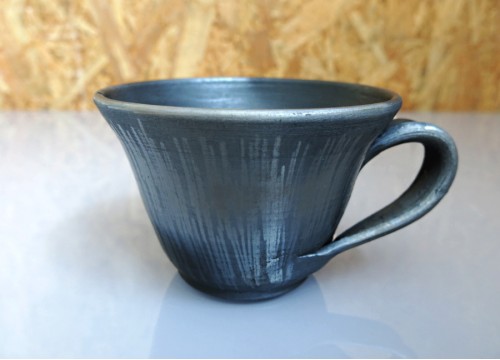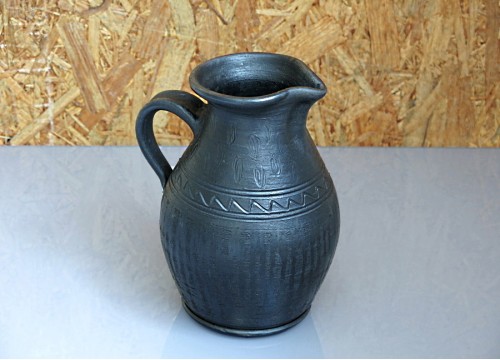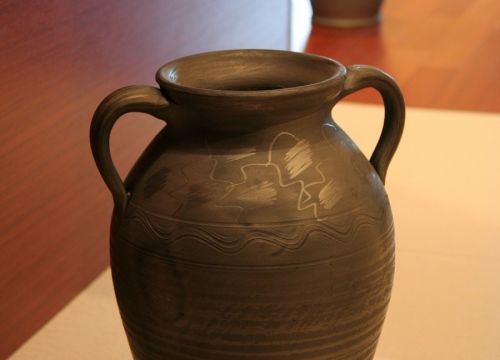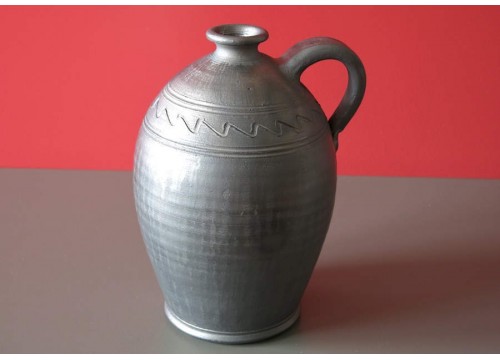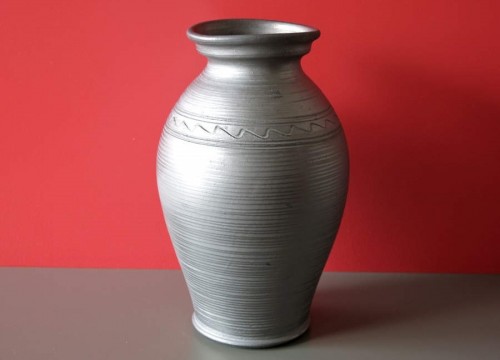
| You have no items in your shopping cart |
Transportation cost: Poland: 14 - 16 zł, Worldwide: from 22 zł

| You have no items in your shopping cart |
A tall, dark grey vase without holders, an example of grey ceramics – pearl of East Region – the most unique and the oldest kind of Polish ceramics, which at present is very rare. It will constitute an impressive element of decoration in both modern and traditional interiors. Grey ceramics is hand manufactured with application of traditional XVIII-century old method. The author kept ornaments typical for „siwaki”. Owing to grinding the vessel with a field flint, it reflects the light, giving unrepeatable effect. It is well worth to pay special attention to proportions of the shape of this vase. The vase is given its author’s monogram, which is burned at the bottom and confirms vase’s origin. Vase’s originality can be recognized also owing to oval, brighter traces on its surface – they pose an effect of traditional way of burning the vessel.
See interior architect’s ideas for taking advantage of „siwaki” in space arrangement – inspirations.
Pottery workshops in Czarna Wieś Kościelna have been cultivating the XVIIIth century traditions of grey pottery handicraft using the same adornments and pot shapes in accordance with the tradition passed on to the consecutive potters’ generations. It is worth emphasizing that every potter has got their own pattern and adornments.
Grey ceramics is the most unique pottery and has the oldest traditions in Poland. Grey pots – in other words dishes manufactured with the use of that technique - appeared on the Polish soil already in the ancient times. They can be traced back to Łużyce culture (1300 – 500 B.C.), Celtic (the IIIrd century B.C.) as well as excavation works from the Roman times (0 – 400 A.D.). What is interesting, polished ornamental adornments that can be found on the dishes from Roman times are made in the identical manner as the contemporary ones. It proves the fact that the grey pots technique making has changed only slightly over centuries.
Research proves that grey ceramics was popular all over Poland. Gradually, due to glazing ceramics development, it was pushed out from different Polish regions, remaining solely in the east.
Grey pottery is produced solely in one village in Poland: Czarna Wieś Kościelna.
.jpg) Mr. Pawel represents the fourth generation continuing pottery traditions. He lives in Czarna Wieś Kościelna, where the pottery has been an inherent element of local traditions since XVIII century. The education on the pottery reguired a lot of work – as he mentioned:”….clay has taught me humbleness…” . Nowadays he specializes in manufacturing of the grey pottery – already unique form of this handicraft. Pawel is the bursar of the Ministry of Culture and National Heritage. He was honored with numerous diplomas and awards. His works are presented in museums in Poland, Russia, Sweden and Lithuania.
Mr. Pawel represents the fourth generation continuing pottery traditions. He lives in Czarna Wieś Kościelna, where the pottery has been an inherent element of local traditions since XVIII century. The education on the pottery reguired a lot of work – as he mentioned:”….clay has taught me humbleness…” . Nowadays he specializes in manufacturing of the grey pottery – already unique form of this handicraft. Pawel is the bursar of the Ministry of Culture and National Heritage. He was honored with numerous diplomas and awards. His works are presented in museums in Poland, Russia, Sweden and Lithuania.
Grey pots making is customarily called ‘grey pots suffocating’. Dishes are rolled on a potter’s wheel. When they are formed, they are adorned. Next they have to dry for a period between a few to over dozen days. The following stage is to prepare a mini lead mixture and ground sand. A pot is covered with that mixture to ensure adequate coating density. Burning dishes in hermetically locked furnaces lasts around 13 – 14 hours. The burning temperature can reach about 950 degrees Celsius (1742 ° Fahrenheit). Only traditional furnaces can be used for grey pottery production, were charcoal is used as fuel. The grey pottery steel-shaded hue is achieved through oxygen reduction from the iron compounds, contained in clay, thanks to stopping the air inflow in the final burning phase. The smooth surface and shine is owed to so call ‘smoothing’ – which involves grinding of a partly-dried dish with an ordinary flint stone.
No customer reviews for the moment.
